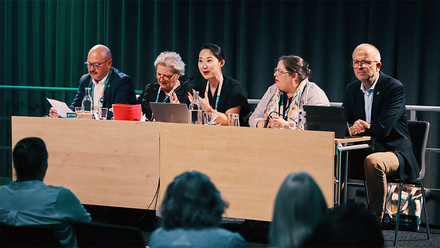Internationalisation and ‘Ethiopianisation’: complementary approaches

How do we balance global outlooks with local needs? In countries like Ethiopia, the drive towards internationalisation coexists alongside the need to tailor higher education to local cultures and realities. The apparent tension between internationalisation and ‘Ethiopianisation’ offers some insights as to how institutions in Europe can collaborate with counterparts in Africa and elsewhere to support both internationalisation and local relevance.
Internationalisation remains under-researched in the African context, and Ethiopia is no exception. The availability of formalised or written policies for internationalisation of higher education at national and institutional levels has most often been an exception rather than a rule in many countries. However, this does not necessarily imply that internationalisation has been totally neglected as an institutional undertaking across the continent.
Ethiopia is one example where two competing policy frameworks provide some insights into the interplay between internationalisation and ‘Ethiopianisation’, illustrating some of the nuances around partnering and collaborating with African institutions.
Internationalisation in policy and practice
Despite the absence of written and coherent policies, most systems and activities in African higher education (including Ethiopia) continue to manifest the ‘traditional’ pillars of internationalisation, such as student and staff mobility and institutional partnership schemes forged with foreign institutions and research organisations.
While the period before the introduction of Western education in Ethiopia was characterised by sending students for foreign studies outside their country, the establishment and development of modern higher education institutions was marked by heavy foreign influences. In fact, the earliest years in the establishment of modern schools were dominated by the borrowing of foreign systems, leaders, advisers and teachers. This strategy was endorsed by the government for the anticipated benefit (ie expertise and resources) it would bring to the underdeveloped local context.
When the University College of Addis Ababa (UCAA) was established in 1950, its president and all the faculty were non-Ethiopian. In fact, UCAA had no Ethiopian faculty until 1955. The same is true of the handful of colleges that sprouted up from 1950–1960.
It is interesting to note that the numbers and nationalities of foreign staff recruited in the early years were partly influenced by the establishment history of the institutions and their affiliations. Since the UCAA was founded by the Canadian Jesuits, most of the staff shared this background. The College of Agriculture in Alemaya (now Haramaya University), an American project, had mainly American instructors. The Swedish who sponsored the Building College (now part of AAU) hired mainly Swedish staff. The Public Health College in Gondar (now Gondar University) had its staff recruited by the World Health Organization, UNICEF and USAID, which sponsored its programmes.
The need for self-sufficiency and localisation are the flip side of internationalisation
The Halie Selassie I University remained a foreign-dominated institution for a significant number of its years: its organisational structure, teachings and course materials had a strong American influence. The university got an Ethiopian president in 1961 (a year after it was established by a merger of five colleges including UCAA), but in that same year expatriates accounted for 75 percent of the staff. That number changed significantly only after the 1974 socialist revolution, which drove many of the Western staff out of the country. Nonetheless, the huge gap created was again filled by staff from socialist countries. The number of expatriates remained around 36% in 1982/83; of course, the percentage of staff who had academic ranks such as assistant, associate or full professor was much higher.
Despite the variety of benefits this mix brought to the higher education sector in the form of diversified perspectives, international teaching and research experiences, the dangers of overreliance, the need for self-sufficiency and localisation were also cited as the flip side of internationalisation. Internationalisation had thus to be counterbalanced by another policy direction whose application was sought in all aspects of university functions.
Ethiopianisation: a balancing act?
Despite being promoted as a capacity-building tool, internationalisation activities have never been taken at face value. There had equally been attempts to reduce the negative effects of internationalisation through a policy direction dubbed as ‘Ethiopianisation’. The first such articulated policy was said to have come from Dr Akiliu Habte, then-dean of the education faculty, who submitted a proposal in 1962 to the first Ethiopian president of the Halie Selassie I University (now Addis Ababa University). The proposal contained a variety of strategies that encouraged the substitution of foreign scholars at all levels and in all sections of the university, though translating this into practice would take decades.
How should partnerships with foreign institutions be designed to ensure equal standing, mutual benefits and the growth of local capacity?
Success in this direction materialised only after three decades of efforts that marked the 1990s as the time in which the dominant roles of Ethiopians in the teaching, administrative and research sections of most higher education institutions were observable. However, similar efforts appear to be lacking in the areas of curriculum development, system borrowing, research collaborations and joint projects with foreign partners, as these and related areas do not seem to have attracted enough attention and have not been pursued with similar zeal.
Another comeback for internationalisation?
The unprecedented expansion of higher education over the last two decades has again increased the need for foreign nationals in Ethiopia. This is mainly due to the human resource shortage, especially in science and technology areas, where 70% of the programmatic focus of Ethiopian institutions is directed. According to information from the Ministry of Education, currently around 8% of the more than 32,000-person higher education workforce is made up by expatriates. In line with this practical need, the government has clearly stated its position of using foreign instructors as a stopgap measure until local capacity is developed.
Additional efforts that promote internationalisation are also underway in the form of developing a national policy, strategies, and institutional frameworks. Higher education institutions are responding to this new change by developing internationalisation policies, hiring foreign instructors, generating research funds from and in collaboration with foreign partners, and even opening branch campuses in neighbouring countries such as Somalia. While these new developments appear to be encouraging, it remains unclear how they balance with the concepts of ‘Ethiopianisation’, a policy direction that has not been clearly articulated and strongly pursued except in the area of staff composition.
The quest for synergy
The Ethiopian government is in the process of developing a new internationalisation policy based on its varied ambitions. Trends at institutional levels echo a similar pattern, with an increasing interest to enrich their internationalisation engagements further. However, such policy directions need to articulate how they may play out against the ideals of Ethiopianisation.
To what extent do the assumptions of Ethiopianisation cohere with the newly-emerging internationalisation initiatives? How do policy directions that encourage drawing substantial resources from outside cohere with Ethiopianisation, which encourages self-sufficiency? How should partnerships with foreign institutions be designed to ensure equal standing, mutual benefits and the growth of local capacity, all of which Ethiopianisation seeks to promote? These and related questions need to be answered satisfactorily as we move into the future, which will continue to accommodate both the unavoidable realities of internationalisation and the drive toward Ethiopianisation.






